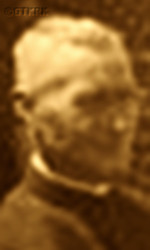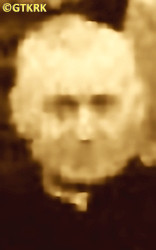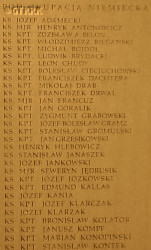Roman Catholic
St Sigismund parish
05-507 Słomczyn
85 Wiślana Str.
Konstancin deanery
Warsaw archdiocese, Poland
full list:
displayClick to display full list

searchClick to search full list by categories
wyświetlKliknij by wyświetlić pełną listę po polsku

szukajKliknij by przeszukać listę wg kategorii po polsku

Martyrology of the clergy — Poland
XX century (1914 – 1989)
personal data
surname
KLARZAK
surname
versions/aliases
KLARCZAK
forename(s)
Joseph (pl. Józef)
function
diocesan priest
creed
Latin (Roman Catholic) Church RCmore on
en.wikipedia.org
[access: 2014.09.21]
diocese / province
Częstochowa diocesemore on
en.wikipedia.org
[access: 2013.05.19]
Włocławek i.e. Kalisz diocesemore on
pl.wikipedia.org
[access: 2019.10.13]
RC Military Ordinariate of Polandmore on
en.wikipedia.org
[access: 2014.12.20]
date and place
of death
19.08.1942

KL Dachauconcentration camp
today: Dachau, Upper Bavaria reg., Bavaria state, Germany
more on
en.wikipedia.org
[access: 2016.05.30]
details of death
reserve chaplain of the Polish Armed Forces.
After the German invasion of Poland on 01.09.1939 (the Russians attacked Poland 17 days later) and the start of World War II, after the beginning of the German occupation, during the search carried out in his parish on 03.09.1939, the Germans discovered a Polish military uniform and scout uniform as well as a military mobilization card (perhaps did not reach the mobilization point in 08.1939).
Together with another priest, Fr Kańtoch, who was brought to his parish by the Germans, tortured and then arrested.
On 04.09.1939, both were driven to Brennowo village (place unknown, possibly refers to Blachownia, or Boronów), where „were ordered to sit in cassocks next to calves standing in feces”.
The next day transported to Dobrodzień, where they were „placed in a garage on a cement floor”, beaten, and the Germans threw their cassocks into the gutter in the mud. The next morning they were told to put them on again.
A few days later transported to the Stalag VIII B Lamsdorf prisoner of war camp.
From there, the prob. on 20.09.1939, transported to the north of Germany, to Oflag X A/Z Itzehoe.
A few months later, on 07.12.1939, transported to the south of Germany, to the POW camp oflag IX C Rotenburg an der Fulda, where the Germans gathered many chaplains of the Polish Army.
Next on c. 17.04.1940, in contravention of Geneva conventions of 27.07.1929, transported as POW to KL Buchenwald concentration camp.
Finally on 06‐07.07.1942 moved to KL Dachau concentration camp where perished.
According to the death certificate, prepared in KL Dachau, the „honest” otherwise German „medical doctors” and formalists — and at the same time, unrivaled fairy tale spinners — noted that the cause of death was Germ. „Versagen von Herz und Kreislauf, bei Ascites” (Eng. „Heart and circulatory failure, due to ascites”).
prisoner camp's numbers
31214Click to display source page (KL DachauClick to display the description), 2995Click to display source page (KL BuchenwaldClick to display the description)
cause of death
extermination: exhaustion and starvation
perpetrators
Germans
sites and events
KL DachauClick to display the description, KL BuchenwaldClick to display the description, Oflag IX C Rotenburg an der FuldaClick to display the description, Oflag X A/Z ItzehoeClick to display the description, Stalag VIII B LamsdorfClick to display the description, Ribbentrop‐MolotovClick to display the description, Pius XI's encyclicalsClick to display the description
date and place
of birth
20.02.1887Birth certification on:
metryki.genealodzy.pl
[access: 2025.08.19]

Aleksandrówtoday: Strzelce gm., Kutno pov., Łódź voiv., Poland
more on
en.wikipedia.org
[access: 2021.10.09]
parents
KLARZAK John
🞲 ?, ? — 🕆 ?, ?

WÓJKOWSKA Florentine
🞲 ?, ? — 🕆 ?, ?
baptism
21.02.1887Birth certification on:
metryki.genealodzy.pl
[access: 2025.08.19]

Strzelcetoday: Strzelce gm., Kutno pov., Łódź voiv., Poland
more on
en.wikipedia.org
[access: 2021.12.18]
Holy Trinity RC church
presbyter (holy orders)
ordination
25.03.1915

Włocławektoday: Włocławek city pov., Kuyavia‐Pomerania voiv., Poland
more on
en.wikipedia.org
[access: 2021.12.18]
Assumption of the Blessed Virgin Mary RC cathedral churchmore on
en.wikipedia.org
[access: 2025.03.14]
positions held
1937 – 1939
parish priest — Kamienica Polskatoday: Kamienica Polska gm., Częstochowa pov., Silesia voiv., Poland
more on
en.wikipedia.org
[access: 2020.12.11] ⋄ St Michael the Archangel RC parish ⋄ Częstochowatoday: Częstochowa city pov., Silesia voiv., Poland
more on
en.wikipedia.org
[access: 2021.12.18] RC deanery
1926 – 1937
parish priest — Ożarówtoday: Mokrsko gm., Wieluń pov., Łódź voiv., Poland
more on
en.wikipedia.org
[access: 2020.12.11] ⋄ St Mary Magdalene RC parish ⋄ Praszkatoday: Praszka gm., Olesno pov., Opole voiv., Poland
more on
en.wikipedia.org
[access: 2020.12.11] RC deanery
1926
administrator — Mierzycetoday: Wierzchlas. gm., Wieluń pov., Łódź voiv., Poland
more on
en.wikipedia.org
[access: 2020.12.11] ⋄ St Catherine the Virgin and Martyr RC parish ⋄ Wieluńtoday: Wieluń gm., Wieluń pov., Łódź voiv., Poland
more on
en.wikipedia.org
[access: 2021.07.18] RC deanery
1924 – 1926
vicar — Mierzycetoday: Wierzchlas. gm., Wieluń pov., Łódź voiv., Poland
more on
en.wikipedia.org
[access: 2020.12.11] ⋄ St Catherine the Virgin and Martyr RC parish ⋄ Wieluńtoday: Wieluń gm., Wieluń pov., Łódź voiv., Poland
more on
en.wikipedia.org
[access: 2021.07.18] RC deanery
1921 – 1924
vicar — Częstochowatoday: Częstochowa city pov., Silesia voiv., Poland
more on
en.wikipedia.org
[access: 2021.12.18] ⋄ Holy Family RC parish ⋄ Częstochowatoday: Częstochowa city pov., Silesia voiv., Poland
more on
en.wikipedia.org
[access: 2021.12.18] RC deanery
1915 – 1921
vicar — Lututówtoday: Lututów gm., Wieruszów pov., Łódź voiv., Poland
more on
en.wikipedia.org
[access: 2020.12.11] ⋄ Holy Trinity and St Matthew the Apostle RC parish ⋄ Wieluńtoday: Wieluń gm., Wieluń pov., Łódź voiv., Poland
more on
en.wikipedia.org
[access: 2021.07.18] RC deanery
1909 – 1915
student — Włocławektoday: Włocławek city pov., Kuyavia‐Pomerania voiv., Poland
more on
en.wikipedia.org
[access: 2021.12.18] ⋄ philosophy and theology, Theological Seminary
chaplain — scoutmaster, Polish Scouting Association ZHP
others related
in death
BELONClick to display biography Zdislav Anthony, BRYDACKIClick to display biography Louis Cyprian, DACHTERAClick to display biography Francis, DRWALClick to display biography Francis, FRANCUZClick to display biography John, GÓRALIKClick to display biography John, JĘDRYSIKClick to display biography Severin (Fr Vincent Mary), KRYŃSKIClick to display biography Adolph Bernard, LISSOWSKIClick to display biography Ceslav Joseph, MICHUŁKAClick to display biography John, MIEGOŃClick to display biography Vladislav, STOPCZAKClick to display biography Marian Conrad, SYPERClick to display biography Stanislav, SZABELSKIClick to display biography Edward Bronislav, ŚWIDEREKClick to display biography Vladislav, TOMIAKClick to display biography Joseph, TRUSSClick to display biography Cyriac Boleslav, ZAKRZEWSKIClick to display biography John, ZIEMIAŃSKIClick to display biography Michael Urban, ZIĘBAClick to display biography Adalbert
sites and events
descriptions
KL Dachau: KL Dachau in German Bavaria, set up in 1933, became the main German Germ. Konzentrationslager (Eng. concentration camp) KL for Catholic priests and religious during World War II: On c. 09.11.1940, Reichsführer‐SS Heinrich Himmler, head of the SS, Gestapo and German police, as a result of the Vatican's intervention, decided to transfer all clergymen detained in various concentration camps to KL Dachau camp. The first major transports took place on 08.12.1940. In KL Dachau Germans held approx. 3,000 priests, including 1,800 Poles. The priests were forced to slave labor in the Germ. „Die Plantage” — the largest herb garden in Europe, managed by the genocidal SS, consisting of many greenhouses, laboratory buildings and arable land, where experiments with new natural medicines were conducted — for many hours, without breaks, without protective clothing, no food. They slaved in construction, e.g. of camp's crematorium. In the barracks ruled hunger, freezing cold in the winter and suffocating heat during the summer, especially acute in 1941‐1942. Prisoners suffered from bouts of illnesses, including tuberculosis. Many were victims of murderous „medical experiments” — in 11.1942 c. 20 were given phlegmon injections; in 07.1942 to 05.1944 c. 120 were used by for malaria experiments. More than 750 Polish clerics where murdered by the Germans, some brought to TA Hartheim euthanasia centre set up in Schloss Hartheim in Austria and murdered in gas chambers. At its peak KL Dachau concentration camps’ system had nearly 100 slave labour sub‐camps located throughout southern Germany and Austria. There were c. 32,000 documented deaths at the camp, and thousands perished without a trace. C. 10,000 of the 30,000 inmates were found sick at the time of liberation, on 29.04.1945, by the USA troops… (more on: www.kz-gedenkstaette-dachau.deClick to attempt to display webpage
[access: 2013.08.10], en.wikipedia.orgClick to attempt to display webpage
[access: 2016.05.30])
KL Buchenwald: In German Germ. Konzentrationslager (Eng. concentration camp) KL Buchenwald concentration camp, founded in 1937 and operational till 1945, Germans held c. 238,380 prisoners and murdered approx. 56,000 of them, among them thousands of Poles. Prisoners were victims of pseudo‐scientific experiments, conducted among others by Behring‐Werke from Marburg and Robert Koch Institute from Berlin companies. They slaved for Gustloff in Weimar and Fritz‐Sauckel companies manufacturing armaments. To support Erla‐Maschinenwerk GmbH in Leipzig, Junkers in Schönebeck (airplanes) and Rautal in Wernigerode Germans organized special sub‐camps. In 1945 there were more than 100 such sub‐camps. Dora concentration camp was initially one of them, as well as KL Ravensbrück sub‐camps (from 08.1944). On 08.04.1945 Polish prisoner, Mr Guido Damazyn, used clandestinely constructed short wave transmitter to sent, together with a Russian prisoner, a short message begging for help. It was received and he got a reply: „KZ Bu. Hold out. Rushing to your aid. Staff of Third Army” (American). Three days later the camp was liberated. (more on: www.buchenwald.deClick to attempt to display webpage
[access: 2013.08.10], en.wikipedia.orgClick to attempt to display webpage
[access: 2013.08.10])
Oflag IX C Rotenburg an der Fulda: German POW prisoner of war camp for officers in Rotenburg an der Fulda in Hesse. C. 60‐70 Polish Catholic priests, most of them military chaplains, captured by the Germans in 09.1939 during German invasion of Poland, were held POW there from 12.1939. In preparations for invasion of France all on 18.04.1940 were sent — in contravention of Geneva conventions of 27.07.1929 — to KL Buchenwald concentration camps. From 06.1940 Germ. Zweiglager (Eng. sub‐camp) of Oflag IX A/H Spangenberg and renamed Oflag IX A/Z. (more on: en.wikipedia.orgClick to attempt to display webpage
[access: 2019.11.17])
Oflag X A/Z Itzehoe: Founded in 01.1939 in Itzehoe in Schleswig‐Holstein and operational at least till 01.1941. First five POWs — a Polish general and 4 other officers — were brought in on 08.09.1939. Within next month at least 5 transports arrived at the camp, each with from 40 to 450 Polish soldiers. Altogether c 1,000 POWs were then held in the camp. Among them were 25 Catholic priests of which 21 were subsequently sent to German concentration camps. In mid 01.1941 Polish officers were moved to another POW camp, Stalag X‐B Sandbostel. (more on: www.shz.deClick to attempt to display webpage
[access: 2020.05.30])
Stalag VIII B Lamsdorf: Stalag VIII B Lamsdorf (from 1943 Stalag 344 Lamsdorf) — German POW camp in Łambinowice, mainly for privates and NCOs. In 1930‐1940 in excess of 40,000 Poles where kept there. Altogether c. 100,000 prisoners from Australia, Belgium, British India, British Palestine, Canada, France, Greece, Italy, the Netherlands, New Zealand, Poland, South Africa, the Soviet Union, the United Kingdom, the Isle of Man, the United States and Yugoslavia passed through this camp. In 1941 a separate camp, Stalag VIII‐F was set up close by to house the Soviet prisoners. (more on: en.wikipedia.orgClick to attempt to display webpage
[access: 2019.11.17])
Ribbentrop‐Molotov: Genocidal Russian‐German alliance pact between Russian leader Joseph Stalin and German leader Adolf Hitler signed on 23.08.1939 in Moscow by respective foreign ministers, Mr. Vyacheslav Molotov for Russia and Joachim von Ribbentrop for Germany. The pact sanctioned and was the direct cause of joint Russian and German invasion of Poland and the outbreak of the World War II in 09.1939. In a political sense, the pact was an attempt to restore the status quo ante before 1914, with one exception, namely the „commercial” exchange of the so‐called „Kingdom of Poland”, which in 1914 was part of the Russian Empire, fore Eastern Galicia (today's western Ukraine), in 1914 belonging to the Austro‐Hungarian Empire. Galicia, including Lviv, was to be taken over by the Russians, the „Kingdom of Poland” — under the name of the General Governorate — Germany. The resultant „war was one of the greatest calamities and dramas of humanity in history, for two atheistic and anti‐Christian ideologies — national and international socialism — rejected God and His fifth Decalogue commandment: Thou shall not kill!” (Abp Stanislav Gądecki, 01.09.2019). The decisions taken — backed up by the betrayal of the formal allies of Poland, France and Germany, which on 12.09.1939, at a joint conference in Abbeville, decided not to provide aid to attacked Poland and not to take military action against Germany (a clear breach of treaty obligations with Poland) — were on 28.09.1939 slightly altered and made more precise when a treaty on „German‐Russian boundaries and friendship” was agreed by the same murderous signatories. One of its findings was establishment of spheres of influence in Central and Eastern Europe and in consequence IV partition of Poland. In one of its secret annexes agreed, that: „the Signatories will not tolerate on its respective territories any Polish propaganda that affects the territory of the other Side. On their respective territories they will suppress all such propaganda and inform each other of the measures taken to accomplish it”. The agreements resulted in a series of meeting between two genocidal organization representing both sides — German Gestapo and Russian NKVD when coordination of efforts to exterminate Polish intelligentsia and Polish leading classes (in Germany called «Intelligenzaktion», in Russia took the form of Katyń massacres) where discussed. Resulted in deaths of hundreds of thousands of Polish intelligentsia, including thousands of priests presented here, and tens of millions of ordinary people,. The results of this Russian‐German pact lasted till 1989 and are still in evidence even today. (more on: en.wikipedia.orgClick to attempt to display webpage
[access: 2015.09.30])
Pius XI's encyclicals: Facing the creation of two totalitarian systems in Europe, which seemed to compete with each other, though there were more similarities than contradictions between them, Pope Pius XI issued in 03.1937 (within 5 days) two encyclicals. In the „Mit brennender Sorge” (Eng. „With Burning Concern”) published on 14.03.1938, condemned the national socialism prevailing in Germany. The Pope wrote: „Whoever, following the old Germanic‐pre‐Christian beliefs, puts various impersonal fate in the place of a personal God, denies the wisdom of God and Providence […], whoever exalts earthly values: race or nation, or state, or state system, representatives of state power or other fundamental values of human society, […] and makes them the highest standard of all values, including religious ones, and idolizes them, this one […] is far from true faith in God and from a worldview corresponding to such faith”. On 19.03.1937, published „Divini Redemptoris” (Eng. „Divine Redeemer”), in which criticized Russian communism, dialectical materialism and the class struggle theory. The Pope wrote: „Communism deprives man of freedom, and therefore the spiritual basis of all life norms. It deprives the human person of all his dignity and any moral support with which he could resist the onslaught of blind passions […] This is the new gospel that Bolshevik and godless communism preaches as a message of salvation and redemption of humanity”… Pius XI demanded that the established human law be subjected to the natural law of God , recommended the implementation of the ideal of a Christian state and society, and called on Catholics to resist. Two years later, National Socialist Germany and Communist Russia came together and started World War II. (more on: www.vatican.vaClick to attempt to display webpage
[access: 2023.05.28], www.vatican.vaClick to attempt to display webpage
[access: 2023.05.28])
sources
personal:
kuriaczestochowa.plClick to attempt to display webpage
[access: 2013.05.19], bibliotekanauki.plClick to attempt to display webpage
[access: 2023.12.15], metryki.genealodzy.plClick to attempt to display webpage
[access: 2025.08.19], www.ipgs.usClick to attempt to display webpage
[access: 2012.11.23]
bibliographical:
„Schematismus Universi Venerabilis Cleri Saecularis et Regularis Dioecesis CzęstochoviensisClick to display source page”, Częstochowa diocesa Curia, 1926‐1939, diocesan printing house
„International Tracing Service (ITS), Bad Arolsen, GermanyClick to display source page”, Arolsen Archives
original images:
www.facebook.comClick to attempt to display webpage
[access: 2016.03.14], doi.orgClick to attempt to display webpage
[access: 2021.10.09], hinterstacheldraht.jimdo.comClick to attempt to display webpage
[access: 2016.03.14], www.katedrapolowa.plClick to attempt to display webpage
[access: 2014.01.16]
LETTER to CUSTODIAN/ADMINISTRATOR
If you have an Email client on your communicator/computer — such as Mozilla Thunderbird, Windows Mail or Microsoft Outlook, described at WikipediaPatrz:
en.wikipedia.org, among others — try the link below, please:
LETTER to CUSTODIAN/ADMINISTRATORClick and try to call your own Email client
If however you do not run such a client or the above link is not active please send an email to the Custodian/Administrator using your account — in your customary email/correspondence engine — at the following address:

giving the following as the subject:
MARTYROLOGY: KLARZAK Joseph
To return to the biography press below:
 Click to return to biography
Click to return to biography












